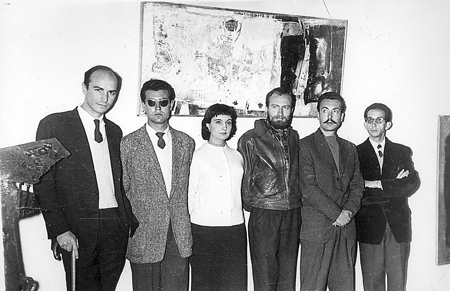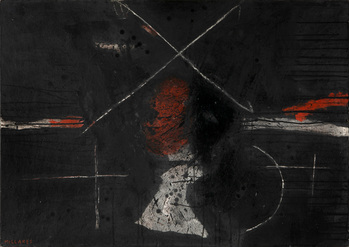The committed and rebellious aesthetic of Manolo Millares
The work in auction represents the creative maturity with which Millares, at the hands of gallery owner Pierre Matisse, grandson of the brilliant painter Henry Matisse, reached the height of his international prestige.


The rebirth of the Spanish avant-garde in the post-war context finds in Manolo Millares one of its great architects whose creative dimension opened a new chapter in the history of Spanish art where the artistic work became a battlefield. In this sense, Manolo Millares, together with the rest of the members of the El Paso group, radically broke with the outdated academicism that prevailed in Spain at the time, to give birth to an art whose combative and critical character stems from the ethical and moral commitment to the society of his weather.
His work, whether before or after joining the group, emerges from the pain and rage generated after the war in what was, as the artist himself defined, a furious duel against which the only possible response was uprising. Confronting established conventions and classic values of harmony, beauty and order, Millares wanted to annihilate any attempt to mask the tragic truths that plagued the 20th century. The ethical plot that formed the backbone of his life and work tells us about his struggle and effort to make effective and describe the truth of his time through art. A truth that precisely because it is, is dramatically heartbreaking.
In this sense, the work on paper that Millares tirelessly developed represents a valuable testimony, not only of his plastic evolution but also of the conceptual change that the discipline itself will experience , whose methods remained rooted in the canons of the 19th century. In Millares, the drawing will be freed from its condition of preparatory work to give way to an autonomous work as in this case, where gesture and color will prevail over the line, giving priority to the expression of thought, as opposed to the mere representation. In fact, the immense capacity that he demonstrates when carrying out work similar to the one he did in his well-known arpilleras, whose aesthetics, sense and gestures, he will be able to instill, even when he dispenses with the expressive power of the material substrate, is striking.
The transcendence that his production on paper would acquire, especially from the 1960s, shines through in the work that concerns us, whose creative maturity reaches its fullness here. In this period, his work will become, if possible, more committed and rebellious, revealing to us the ethics and aesthetics of man destroyed by man. In the face of violence, oppression and recurrent injustice in the history of humanity, Millares will turn his work into the expression of his need to mourn a man who, unable to learn, dies of ignorance.

The 1960s will also be the time of its resounding international recognition, where the figure of the gallery owner Pierre Matisse will play a decisive role . Despite the impetus that his participation in 1957 in the São Paulo Biennial represented, his work did not reach a significant presence outside our borders until 1959, when one morning in August he received a surprising telegram from Matisse expressing his desire to present his work in America. Far from being the result of chance, the sudden interest in the work of Millares by one of the most influential figures in the international art market at the time, involved a shadowy architect of the stature of Joan Miró. After attending the exhibition “4 painters from El Paso” opened in the Gaspar room in 1959, Miró was so pleasantly impressed that he did not hesitate to propose to Matisse that he include the Canarian artist among the list of European painters that he was making known in the United States. As a result of this curious concatenation of circumstances, the projection of Manolo Millares in the international market will be consolidated and expanded under the support that Matisse gave him, whose support and admiration will endure even after the artist’s premature death.
The works that Pierre selected during these years belong to a period of deep anguish that Millares translated plastically into what are his darkest works . Through them, the black streak of the Spanish pictorial tradition will be manifested as never before and especially of his admired Goya, in whose tragic drama we find the deepest roots of his plastic language. The large black masses extended by means of thick and dripping brushstrokes will now dominate the entirety of a pictorial surface in dialogue with the white and red tones of the scratches, crosses, circles and archaic signs that emerge from the darkness like open wounds. Each stroke, stain, and symbol are transformed here, in the sublimated gestures of the violence inflicted on civil society.
The critical and rebellious rebellious spirit that illuminated all his work is wonderfully synthesized in the artist’s own words when in 1959 he stated that “Art should not be because it pleases (we are not in times of good digestion or laughing at nonsense) but rather because it hurts furiously. No explanations or understanding. Art cannot be the comfortable seat of the intangible, but the terrifying bed where we all lay down to give a timeless greeting to the guardian death”. His is one of those works whose honesty, humanity and courage remain undying.






